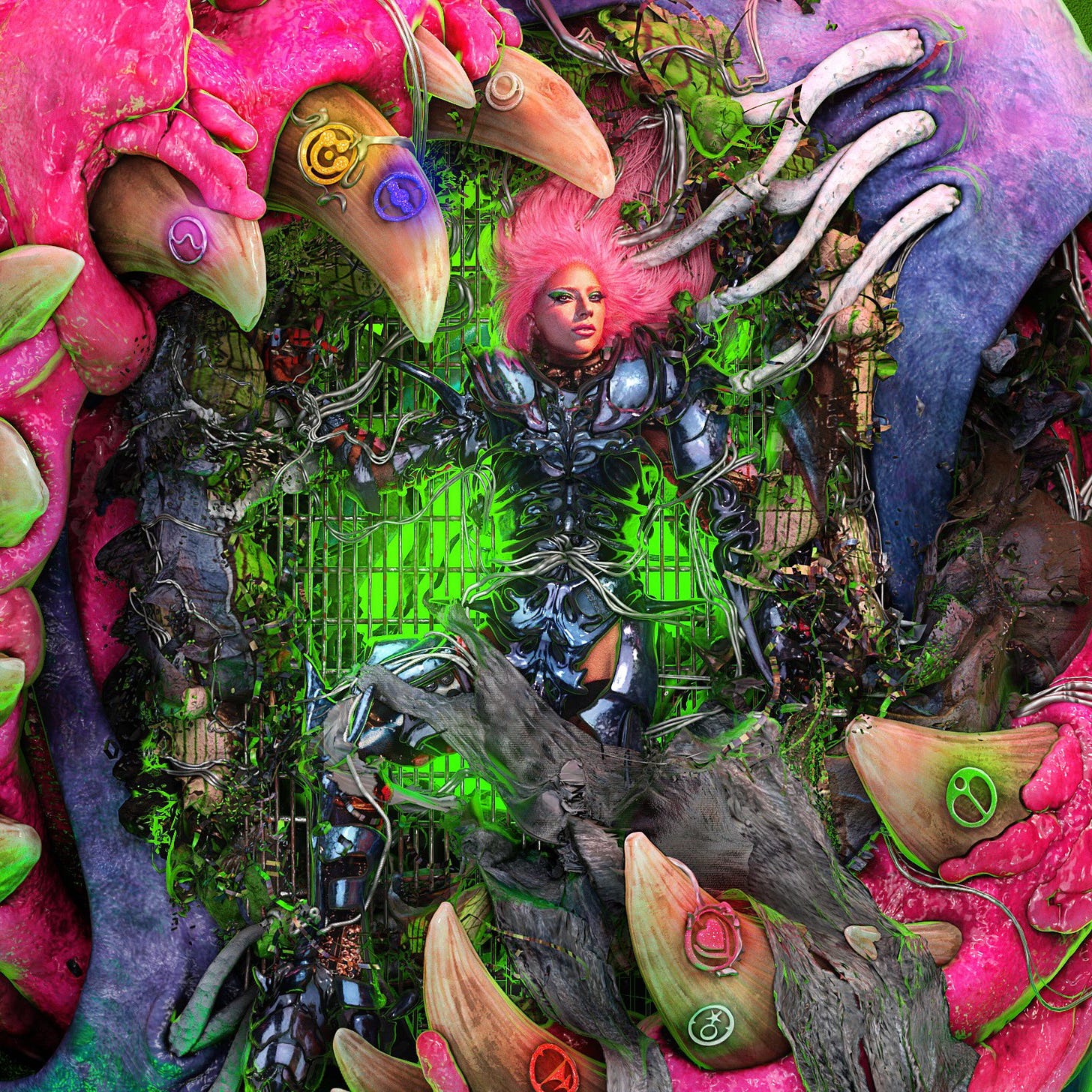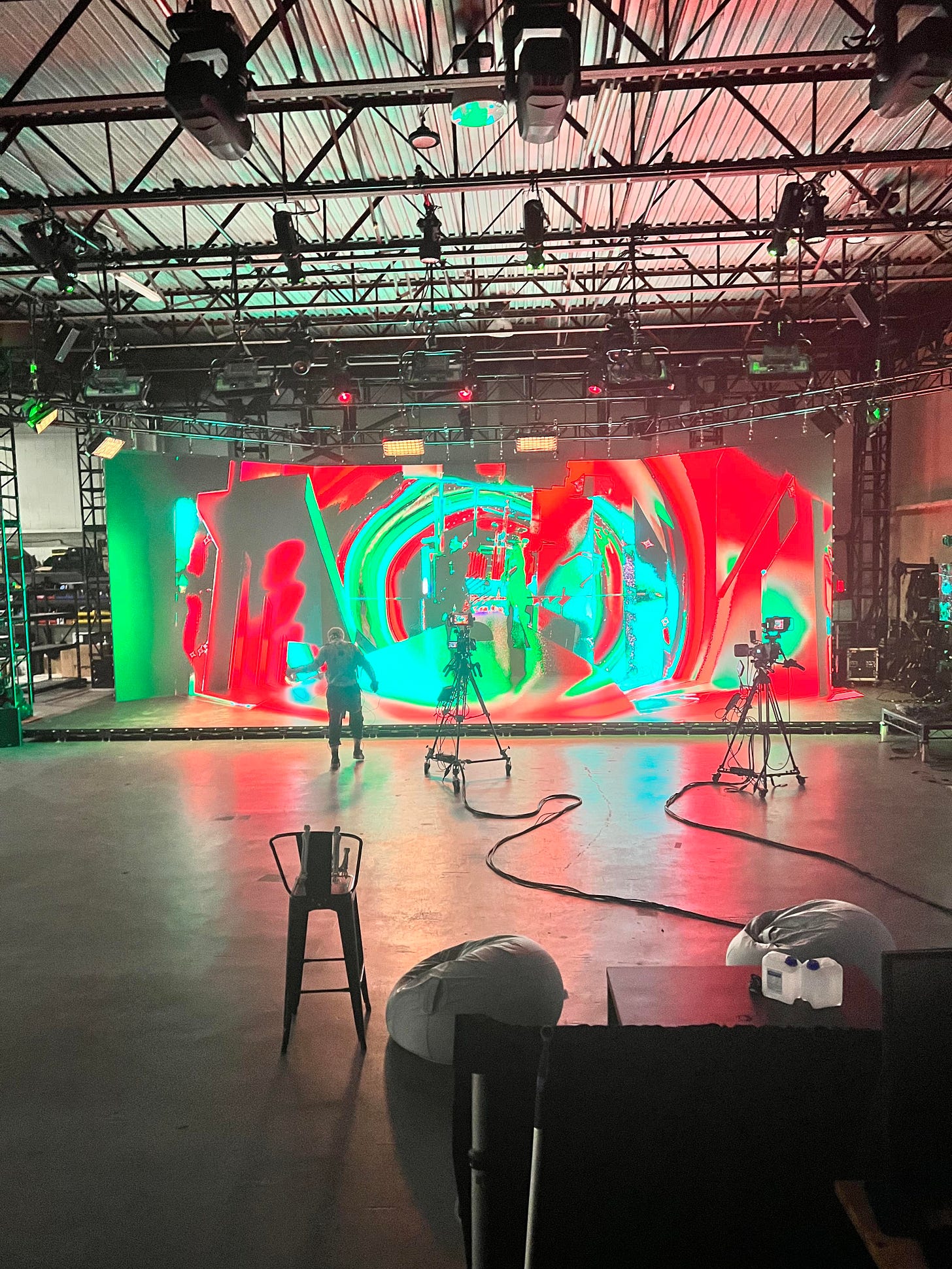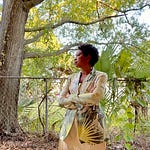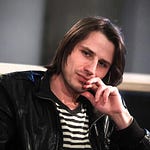This is episode #002 of the FuturePerfect Podcast where we talk with compelling people breaking new ground in art, media, and entertainment. This podcast is produced by FuturePerfect Studio, an extended reality studio creating immersive experiences for global audiences. Episodes are released every two weeks, visit our website futureperfect.studio for more details.
The text version of this interview has been edited for length and clarity. Find the full audio version above or in your favorite podcast app.
This week we interview Team Rolfes, a digital performance and image studio led by Sam and Andy Rolfes. The studio specializes in figurative animation, VR puppetry, and mixed reality collage. They create works across multiple formats, including livestream improvisational comedy, live motion capture animation on large festival stages and in underground rave bunkers, print design for fashion collections, album covers and music videos.
They have collaborated with Lady Gaga, Danny Elfman, Danny L Harle, Nike, Netflix, Adult Swim and performed at music festivals across the world. On June 4th, 2022, they will premiere their live 3D musical 3-2-1 RULE at Carriageworks in Sydney, Australia. The work is being developed together with writer and net artist Jacob Bakkila and artist songwriter Lil Mariko.
I first encountered your work as an online video in 2020 as a part of the Lunchmeat Festival of electronic music and art based in Prague. I think it was called Sam Rolfes 360° AV experience. I watched it on my Oculus headset and the work was so exhilarating, but also disconcerting and humorous at the same time. It was like a fever dream complete with moving walls, objects melting, spaces constantly changing sizes, and yet was extremely beautiful.
For me, the work exemplified this intriguing in-betweenness that you embrace: part puppet show, theme park ride, sculpture, live performance, gaming, and installation. And this makes absolute sense because you've been making experiences across media and genres for a very long time.
You were both originally trained in painting and fine art. How did you get from there to the work that you're doing now?
Sam Rolfes: Yes, Andy and I both come from a painting background. Our mom was a painter. She ran a little 3D studio when we were kids. She had these big huge books on Blender and 3ds Max laying around.
Andy Rolfes: It was a long path back to 3D. We played around with 2D a lot more. We read about musculature systems in the 3D books and wondered how in the world people can even set this stuff up.
SR: There was also a lot about wireframes. When we were kids 3D was just kind of boring. It felt like math and I didn’t want to do math I just wanted to make a cool race car.
AR: Yeah a lot of math. I remember making a sword in Blender when I was 12. It’s a pretty linear shape, but it was the most taxing process. So I went back to 2D. I could just play with a plane and an abstraction and it was more fun.
These 3D tools, along with game engines and other design software, have become some of the most significant toolsets for conceptualizing and building your work. What happened in terms of your training where you suddenly realized you needed to leave painting and watercolor and shift into 3D?
SR: I don't remember how I came across it, but I came across ZBrush, a 3D sculpting program where you can mash things around like digital clay. That was the big aha moment for me. A lot times it hides (honestly oftentimes to its detriment) the mathy elements and we found that it was actually in keeping with our painting background where it allows for semi-improvisation, but with an impressionistic sculptural object. Andy started playing more with Maya and Blender as well. And we both slowly got into it just because it was fun.
AR: I went through the whole watercolor track and was doing semi-pro photography and developing an interest in photogrammetry. As I was seeing Sam play around with ZBrush, I got into it and jumped back into 3D. I actually went back to 3ds Max. I was putting photogrammetry scans in there and throwing grass around and rendering that out and realized it had gotten way better. And I started bringing in my 2D stuff and playing with ways to collage that in. I played around with that and Cinema 4D before I ended up going back to ZBrush.
SR: This was in tandem with the 2012 to 2016 era of internet art and post internet art. There were a lot of people doing 3D art. They would kind of kludge something together in Maya and make it shiny and spin around. And that stuff still exists to some extent these days, but was increasingly present in Chicago where I was living at the time. I had just moved back from Austin after being there for a year after graduating art school.
I was starting to do more show flyers and stuff like that and I was trying to find whatever scene existed in Chicago. You wouldn't know it because none of the people would actually hang out in person, but a lot of interesting things in the glitch scene and post internet scene were coming out of Chicago. I was trying to engage with this new community and was finding our perspective within that.
I realized we could take a different approach because of our painting background. All these other people were coming more from a digital art or computer science background. They had an art game program at SAIC where I went to school, but I was so turned off by it because everybody was making these white box gallery experiences and they were all the same. That was one reason why it took me a while to get into Unreal Engine. I was still traumatized by having to virtually walk through all these terribly designed spaces.
And then I started doing music videos. Our first one was for this group Amnesia Scanner. And I started using ZBrush as a live visual performance tool and did visuals for shows. I would make characters for every musician performing. There’s no real rigging in ZBrush, but I managed to make the characters bounce around like marionettes. From there I got a bit of an understanding of realtime performance.
And then Amnesia Scanner kind of blew up on the internet. We don't reach out to musicians like this, but I just like sent them an email. They're very mysterious and I didn't know where they were based. I sent them an email that was in four different languages that was like, please let's work together. And they responded to me. So I spent two months with an initial dev trying out both Unity and Unreal. And Unreal ended up being better.
I got in contact through a friend of a friend with this guy Eric Anderson, who was running a three-story punk venue in Chicago called The Keep. We met and he had a prototype Oculus Rift. This was back in 2015 or something like that. And I went to this DIY spot and then stayed there for a week and we just banged out this crazy video. I just palmed the prototype Oculus headset to do the camera. There was no sequencer and there was nothing rendered in Unreal. This was all recorded. I exported it all and took it to my painting mentor's place and uploaded it to his 12 year old daughter's gaming computer. And it took like 24 hours for it to load on that computer and then we performed it there and just recorded it straight from the screen. It felt good enough that we kind of just kept running with it for everything after that.
So in terms of music, your past works have a long dialogue with rave culture, hyperpop, and new forms of media that circulate on the internet. Tell us more about that dialogue and how it informs some of your current work.
AR: I was kind of plugged into, or at least aware of, both vaporwave and glitch and everything in between that, like the acerbic visuals and everyone realizing 3D is a lot more approachable. The communities I’ve engaged with have definitely been varied and scattered. It’s a lot of pulling things together and trying to figure out what works. Up until recently not many friends or people I’ve know have directly engaged with 3D. But I show them what I’m working on and try to connect different communities together and see how we can work together.
SR: And more recently you’ve been more active in the visual artist communities than I have. I've been more interested in those rave cultures. I have a long career of DJing and producing. I've been in the turntable scene, the glitch hop scene, the witch house scene, and now it’s hyperpop. It all ends up being the same. The through line is just experimentalism basically. It's just like a certain amount of interest in a new sound.
Hyperpop is an interesting illustration of this to talk about because it's this weird thing where underground culture was made mainstream and at the same time, at least initially, was not diluted upon becoming mainstream. I guess this has happened all the time, but it's the most recent occurrence that I participated in. Hyperpop is this weird sound that somehow a ton of people know about and it became a meme and a joke because of course it was gonna be. But watching that dynamic was very interesting.
We've had a long history with different music scenes. Both me performing as a DJ, but also us doing stage performances with musicians on big festival stages with mocap (motion capture) VR performances that are kind of accompaniments to their music. We've got an opera and a kind of a 3D musical in the works right now. But where it all started was album covers and then music videos. It was about participating in those communities and finding a way to, as visual artists, be a part if it more than just fans, but actually help shape the ideas and shape where everything is going.
What are the ideas you're shaping? What's the content and the substance of what you’re trying to shape right now?
SR: Generally we try and get in and maybe expand the visual dynamic range. With a lot of experimental approaches, especially in the music scenes, it ends up being a lot about vibe or the nerdy tech or kind of esoteric stuff. For us, we can use all these esoteric tech tools, but use them hopefully for a compelling overarching narrative.
And I’m sure we’ll talk more about the performative aspects of our work with using digital tools. But in these electronic scenes it ends up losing a certain humanity. A lot of it for us has been trying to reconnect to this live, in-the-moment feeling. Our work is trying to hit the same subconscious feeling of being in the moment and having all these things happening rather than have some kind of contrived tech demo construction or something.
AR: Especially nowadays where people are like—oh yeah I need to touch grass. We want to somehow bring that back to the digital and think how can we make this more physical? We’re combining that with strong motivations and guiding lights in theater, performance, athletics, heavy physicality. And we’re thinking what can we really do with having our bodies fling around, often literally, and have that cascade and become a deeper narrative that also has its own motivations of speaking to the community or wherever our eyes are fixated at the moment.
Performance in front of a live audience is super central to you guys. Give us a sense of the infrastructure you need to build in order to create one of your dynamic realtime performances. How does it work compositionally, dramaturgically and technically? What does it take to put together and create a realtime dynamic performance in front of a live audience.
SR: Right now, one of our projects is this stage adaptation for this short film, this bigger thing 3-2-1 RULE that’s going to debut in Australia in a month. That one is going to be significantly more structured and quality controlled beforehand rather than being a crazy thing where it’s incredibly improvisational. Often times each show is purpose built to a certain extent. Most of our projects inherit worlds and characters and assets from previous projects, but they they build on each other. We’ll have a collection of scenes that are modular and existing in the same world. Each one is setup for a specific type of camera shot and a specific type of motion capture or VR mechanic.
AR: Before we get into designing the motion, we also have to figure what the arc of the performance is. What's the energy, what modes want to fit where? Is this going to be a soft moment or is it going to be more excitable? We chart the long arc and mini arcs of the scene.
SR: Oftentimes we're not able to meet with the musicians until we get to whatever country we're going to. Prior to meeting them we set up these modular scenes, each with their arc in terms of mechanics and scene dynamic. We have a whole collection of things and plug them together to an extent. Because the performances are so improvisational, it’s kind of like acting the part of a good DJ who’s watching the audience, watching the musicians, listening, and deciding what’s right in the moment.
We work this way when we're making music videos as well. Where we build the environment in VR and then kind of feel out where the choreography of a scene is supposed to go. This big Australian debut of 3-2-1 RULE is going to be pretty regimented. We’re going to have everything planned, but there’s still going to be a fair amount of improvisation since it’s all realtime. I would never want to cut out the potential for those kind of magical moments to happen.
It sounds like 3-2-1 RULE is a very important transitional project for you where you're in control of the narrative and you're not in service of some other musicians. Tell me where the title 3-2-1 RULE comes from and give me a sense of what you're producing.
SR: The name comes from this backup strategy in tech where you’re supposed to have three backups. I'm gonna get this wrong, but one is local, one is on the cloud, and one is offsite. The staged work is an adaptation of a short film and will eventually be either a feature film or a playable game. It’s one of the major projects for us this year. It’s kind of a parody of both the metaverse stuff and the contemporary moment. But also a way to talk about memory and people’s relationships and history together on the internet and what happens when you use the cloud platforms as a prosthetic brain or a prosthetic memory where you’re offloading moments together.
The work follows these gig economy workers who respond to listings posted on an app that gathers memories for people in a metaverse space. If someone wants to remember the best day they ever had or the way their dad danced around when he made breakfast they would use this app and the gig economy workers dive in and play these genre parody games to unlock the memory for them. The conceit is that AI can obviously go in and scan your brain or scan the internet and grab this stuff, but it could never recreate the senses that really make up the core of what the memory is. So you have these gig economy workers who kind of chemically collage and assemble these things together for their clients.
The stage adaptation served the dual function of giving us an excuse to start building out everything for this broader narrative project really fast. And to start developing this format that's closer to a musical. The debut in Australia will be with the musician Lil Mariko, but the idea is that we would put this on all over the world, and it could be any musician friend that would star in this role. It might be customized for each musician a bit. There are moments where there’s narrative and there are moments were they could just perform their songs.
This is kind of our pitch for a new performance format that could be replicated elsewhere and could really bring variety to the music performance world. Because I mean I love music shows. I love venues. I love playing them. I love going to them. I'm at them all the time. But I'm sick of music shows and the format has hardly changed. There exists this potential to unite all these different formats including visuals, sound, music, and narrative. And it takes a little more work. But I think we might be good people to try it out.
You're working with writer and social network artist Jacob Bakkila. What is he bringing to the work?
SR: We initially brought Jacob in on our now defunct Netflix project we were developing. He has a whole career of performing as bots on the internet or doing genre parody things and all these satirical things that are really brilliant. The project was going really well, but there was too much red tape and it got canceled. But we were talking afterward about working together and we had a kernel of the idea for 3-2-1 RULE. He said, okay I think I can do this and went away for a few days and came back with the base concept for 3-2-1 RULE. And it just threaded the needle between stuff that our team had already been working on for our game and other projects.
I work directly with Jacob on the broader concepts and the story and where it goes, but he can churn out hilarious writing very quickly. It’s a mishmash of different online references from every generation and he’s so conversant in that kind of dialogue that he can make it feel genuinely realistic. He's able to sit in this incredibly online space that I feel is very essential to this story. He just generally knows how to fit everything together in a very nice way and was able to bring the emotion to the project.
Do you have a sense of what you want the audience to experience? What do you want them to come away with? What kind of impact do you want to have on them?
SR: Maybe it varies a bit between the live show, the eventual short, and then whatever the final big project is. I want it to be jarring, but funny. I want it to reflect upon our online relationships and what we've given up in terms of community, interpersonal dialogue, memory and moments together. How much are we sacrificing for platforms?
Would it be safe to say that you obviously have a fraught relationship with these platforms? You've experimented in these spaces, you draw inspiration from these spaces, you post in these spaces, and simultaneously, you're frustrated and critical of these spaces.
SR: We’re participating in them because there really is no alternative. I have friends who are making their own distributed web3 based platforms like people doing Channel and people doing other projects, like more horizontal lefty things here and there. But they still have to promote it on platforms because that is just where all this stuff exists.
So much of our stuff, especially if it has any narrative, does have a platform critical element to it because I can't think of anything else to comment on. It feels so absurd to be forced to fit this art that we do, that could take so many different forms, into a box that’s 1080 by 1080 pixels and lasts a minute. There's always been constraints to art, but with platforms it's not a meritocracy, and the best stuff does not rise to the surface. The platforms themselves do not promote things that are in keeping with the value system of anybody within their right minds. It promotes things that will do well on the platform for its own good.
I don't think that’s a healthy thing for an artistic community, or for an artist, or for anything. I think most people recognize this to an extent. In a sense, critiquing it and putting it in my little skits is just coping. It’s like acknowledging it, but I only have so much ability to actually do anything about it. It’s also just generally frustrating with the moment we’re in. The trick is speaking to that moment and then not getting too trapped in the Twitter style riffing on the discourse of the day. That stuff will do better, it is incentivized because you will get better metrics and the platforms want that kind of momentary ephemeral thing. But then if you go back a week later, it doesn't hit the same. So that's also a trap.
Having things be somehow engaging with the contemporary moment, acknowledging where we are right now, and what our relation is to these platforms and to the economy and to how they have basically become the air we breath. Doing that and then also figuring out how you have it be something that lasts longer than 10 minutes is always a struggle artistically.
In all of our discussion we haven't touched on the literal politics of the day. I mean, we haven't talked about Ukraine, we haven't talked about Russia. We haven't talked about the elections. We haven't talked about any of that. What's your relationship to these events and the work you’re doing? Is it something you avoid, something you engage with, or something you don't wanna participate in?
SR: All the political discourse, at least between the conservative and liberal sphere, I don't give a shit about. My interest is in the working class relation to their power, and collective bargaining and what we can do about it. I have opinions about imperialism and being against it and what the US should be doing abroad. But a much more tangible thing to engage with is union and platform issues.
AR: It feels more actionable. Stuff that doesn’t feel like beating the same drum. We’re not trying to be Beeple where we just do modern day political cartoons.
SR: That’s that momentary discourse thing I'm talking about where it’s like oh, I'm going to make an Elon thing. Like who cares?
AR: It feels far too ephemeral. And there's a time in place for that, the political art.
SR: And I have done some stuff like that, I mean I've thrown Zuckerberg into some shit, but I don't know.
AR: But that's also trying to keep things contemporary and keeping with a sense of immediacy. I feel like we usually try to tie things down to more. Not really universal, well sort of universal because working class issues are fairly universal outside of maybe the top 1%. But try to speak to the broader issues, and try to speak more to the individual themselves rather than trying to talk to political issues that will come and go all the time. Even if they don't seem like they ever go away.
SR: Talking about the news of the day and making art about the news of the day is both a symptom of a broader issue that is very much not the discourse in the mainstream media or however you wanna phrase it. Not to sound like too much like a post-left guy, but it's a liberal trap to make your art about an issue that is being discussed by the media that you have no control over. It's a liberal trap in that it is a culture war fabrication that art can change the world. Like if we make the most moral Disney movie, then everybody will be good. It ignores people’s relation to their labor and all these other things. It’s like, if we have no more bad villains who do problematic things on TV, then everybody's gonna be okay.
And I think a lot of artists end up in that trap, feeling the push to have to make work about things like this. Both because it's incentivized by the platform, and because again it's the churn of the daily discourse you're supposed to plug into. And just morally they feel like oh, I have to be saying something. And I'm not saying that my stuff is not cope because there's a left version of this that is just cope too. But it’s just like posting on Twitter. It's not doing anything. We've all been trained to be cultural commentators. All we are doing is quote tweeting people endlessly while the same structural system continues. And I just have no interest in participating in that. It's entertainment at the end of the day and it's entertainment for some people and my stuff is entertainment for lefty types and I'm not necessarily accomplishing anything more, but I at least think that the topics that I'm interested in maybe are more realistically accomplished.
AR: I usually just look to the actual items. I just made an artwork for the Queer Museum of Digital Art, which is part of the whole web3 sphere. They’re trying to fundraise.
SR: Just to clarify, I was not talking about that kind of stuff. I'm not saying that fundraising's bad or anything like that.
AR: I know. I know. For Ukraine or other huge issues, I’m just going to donate or help however I can. If sharing something might help connect one or two other people, I’m aware of my presence as a node within this whole network. If i’m one of a thousand other people sharing this, but there are three other people in my network who didn't see this it’s cool if it’s actionable. Not if it’s just hot takes.
SR: That community building is also way more important than making art about it. Communities can make art and have that steer people in a certain direction. Just to self roast a little bit, if I made the most perfectly leftist take down of whatever, that doesn't accomplish anything either. So making these alternative structures, not to get into dual power talk, but building community structures that exist outside of these platform capital dependent things, I think is the most important thing.
What communities are you working with specifically?
SR: I have yet to start helping them really in a way that I can give myself credit for, but Jaded is a new organization. It’s some people from the Black Socialists in America, Zack Fox, and a bunch of comedians have started this artist co-op and community. They're building a venue, they’re going to be funding scripts, they just debuted this podcast they're doing. Black Socialists in America also have all these other projects like The Dual Power App, which helps give people tools for building co-ops and horizontal things and community structures that don't rely on basic finance capital. They are a great example.
And then Channel, I did some work for them. They’re a web3 venture. I don't want to over explain their thing because I will probably do a bad job. They've done a lot of platform critical work, podcasts, and they're a bunch of lefty artists. But from time to time they would get shadowbanned. And they are still, regardless of how critical they are, dependent on these platforms to a certain extent. They’re working to untether that. In the same way that people are tethered to their jobs because they can't get universal healthcare, they have to stay at the job for healthcare. To give themselves a life raft or a way to untether from that toxic situation, the idea is that basically their followers are on the chain so that they can move to whatever platform. You don’t lose followers when you jump somewhere else. It's a first step towards an alternative platform structure or an alternative community structure that does not rely on passing through AWS and Google and relying on this huge stack from just a couple companies.
Both of them, Channel and Jaded are awesome examples, and we help where we can.
That's great. This really helps fill in a whole other part of your practice that I’m learning more and more about all the time. So I’m super excited to hear you talk about that.
We have so many things in common and we have some really interesting overlapping happening between Team Rolfes and FuturePerfect Studio. It’s very exciting and I can’t wait to see more of your work and have more conversations with both of you.

















Share this post